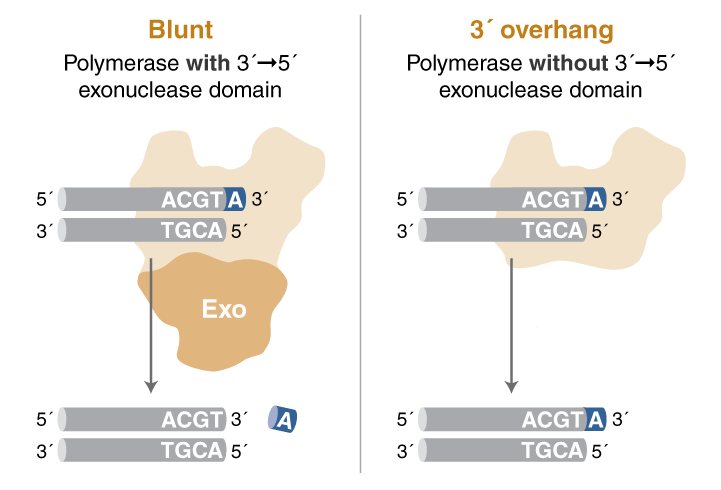|
APPLICATION |
POLYMERASE PRODUCTS |
PCR PRODUCT ENDS |
|
High fidelity PCR |
Q5® polymerases |
Blunt |
|
Phusion® polymerases |
Blunt |
|
|
Routine & Specialty PCR |
OneTaq® polymerases |
3'A/blunt |
|
Taq polymerases |
3'A |
|
|
LongAmp® polymerases |
3'A/blunt |
|
|
Hemo KlenTaq Polymerase |
3'A |
|
|
Isothermal amplification |
Bst polymerases |
3'A |
|
Bsu Polymerase |
3'A |
|
|
phi29 Polymerase |
Blunt |
|
|
DNA manipulation |
T7 DNA Polymerase |
Blunt |
|
E. coli DNA Polymerase I |
Blunt |
|
|
DNA Polymerase I, Large (Klenow) Fragment |
Blunt |
|
|
Klenow Fragment (3′-5′ exo-) |
3'A |
|
|
T4 DNA Polymerase |
Blunt |
|
|
Vent® Polymerase |
Blunt |
|
|
Vent® (exo-) Polymerase |
3'A |
|
|
Deep Vent® Polymerase |
Blunt |
|
|
Deep Vent® (exo-) Polymerase |
3'A |
For more details about our polymerases, including exonuclease activities and applications, please visit our DNA Polymerase Selection Chart.
Learn More
For more information about exonuclease activity, check out this FAQ.
Why do some polymerases blunt and others add a nucleotide?
Polymerases that possess proofreading (3´-5´ exonuclease) activity, such as Q5, Phusion, and Deep Vent, will add an untemplated nucleotide to the 3' ends of extended DNA fragments, but the exonuclease activity subsequently removes it.
Other polymerases that lack 3´-5´ exonuclease activity (such as Taq and Taq-based polymerases) will add an extra nucleotide to 3´ ends (predominantly, but not exclusively, dA) and leave the untemplated overhang intact. This is why it is important to know which polymerase to use when performing blunt-end or T/A cloning.
OneTaq and LongAmp Taq DNA polymerases are optimized blends of Taq (a Family A polymerase) and Deep Vent (a Family B polymerase) DNA Polymerases. The intrinsic polymerase activity of Taq adds a non-templated 3´A, while the 3´–5´ exonuclease activity of Deep Vent increases the fidelity and robustness of Taq, but also blunts PCR products. This is why these products produce a mixture of DNA ends. However, the majority of ends will have a 3'A overhang.

